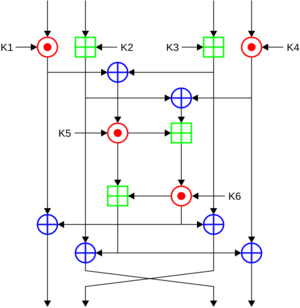International Data Encryption Algorithm facts for kids
The International Data Encryption Algorithm (IDEA) is a special way to keep information secret. It's a type of block cipher, which means it scrambles data in fixed-size chunks. Two smart people, Xuejia Lai and James Massey, created IDEA in 1991.
They designed it to replace an older method called the Data Encryption Standard. IDEA was actually an improved version of an earlier system called the Proposed Encryption Standard (PES). That's why it was first known as IPES, which stands for "Improved PES."
Contents
What is IDEA?
IDEA is a way to protect digital information. It works by changing your data into a secret code. This process is called encryption. Only someone with the right "key" can unlock the code and read the original message. This is called decryption.
IDEA uses a 128-bit key, which is like a very long password. It works on blocks of data that are 64 bits long. Think of it like a puzzle where you scramble 64 pieces at a time.
How IDEA Works
IDEA uses a series of steps to scramble the data. It goes through eight main steps, called "rounds." Then, it has a final half-step. This makes a total of 8.5 rounds.
The way IDEA encrypts (scrambles) and decrypts (unscrambles) information is very similar. This makes it efficient to use.
Mixing Math Operations
IDEA gets its strength from mixing different types of math. It uses:
- Adding and multiplying numbers in a special way (called modular arithmetic).
- A logic operation called eXclusive OR (XOR).
These different math types are "algebraically incompatible." This means they don't easily combine, which makes the code harder to break.
Using Sub-Keys
During each round, IDEA uses small secret codes called "sub-keys." There are six sub-keys for each of the eight main rounds. The final half-round uses four sub-keys.
In total, IDEA uses 52 sub-keys. Each sub-key is 16 bits long. These sub-keys are created from the main 128-bit key. The main key is rotated and shifted to create all the different sub-keys needed.
Security and Patents
When IDEA was designed, its creators studied how strong it was against attacks. They found it was very hard to break using certain methods. No one has successfully broken the full IDEA cipher using common attack methods like linear or differential attacks.
Some very rare "weak keys" have been found. But these are so uncommon that they can easily be avoided. As of 2007, the best attacks could only break IDEA if it used fewer rounds (6 rounds instead of the full 8.5).
Patents and Use
IDEA was protected by patents in many countries. A patent gives the creator the right to control who can use their invention. However, people could use IDEA for free if it was not for business purposes. The patents expired around 2010–2011.
The name "IDEA" is also a trademark. Today, a company called MediaCrypt licenses IDEA for use around the world.
IDEA in Real Life
IDEA was used in an important program called Pretty Good Privacy (PGP) version 2.0. PGP is a popular tool for sending secure emails and files. IDEA was chosen for PGP after an earlier encryption method was found to be breakable.
IDEA can also be used with the OpenPGP standard, which is a widely accepted way to encrypt data.
Expert Opinions
In 1996, a famous expert named Bruce Schneier said that IDEA was "the best and most secure block algorithm available to the public." He wrote this in his well-known book, Applied Cryptography.
However, by 1999, Schneier stopped recommending IDEA as much. This was because newer, faster encryption methods became available. Also, some progress was made in trying to break IDEA, and the patent issues made it less appealing for some uses.
See also
 In Spanish: International Data Encryption Algorithm para niños
In Spanish: International Data Encryption Algorithm para niños


